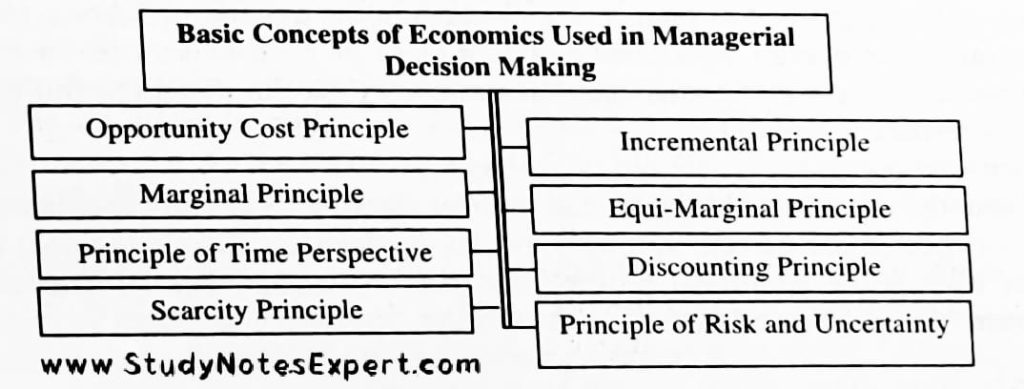Role of Managerial Economics in Decision Making
Various principles or fundamental concepts and analytical tools which are offered by managerial economics, are used by modern business organisations in decision-making process. Relationship of Managerial Economics with other Disciplines helps in decision making. These can be explained as under:

1. Opportunity Cost Principle
The sacrifice of alternative courses of action for any decision is referred to as opportunity cost. Opportunity cost may be defined as, ‘the revenue foregone or opportunity lost by not using the resources in second best alternative use’. It is also called imputed cost. Measurement of sacrifice is done by opportunity cost. It is shown as the role of managerial economics in decision making. The sacrifice which is made for taking a decision is measured by opportunity cost. This concept can be explained by following points:
- The opportunity cost of the funds employed in one’s own business is the interest that could be earned on those funds had they been employed in other ventures.
- The opportunity cost is the value of time an entrepreneur devotes to him
- Business is the salary he could earn in any field with other occupations.
- The opportunity cost of using a machine to produce one product is the earnings for gone which would have been possible from other products.
- The opportunity cost of using a machine that is useless for any other purpose is Zero since its use requires no sacrifice of other opportunities.
Thus, it should be remembered that opportunity costs require ascertainment of sacrifices. If a decision involves no sacrifices, its opportunity cost is nil. For decision-making, opportunity costs are the only relevant costs. The opportunity cost principle may be stated as, “The cost involved in any decision consists of the sacrifices of alternatives required by that decision. If there are no sacrifices, there is no cost.”
2. Incremental Principle
Marginal Cost and marginal revenue of economics theory are related with incremental principle concept. Estimation of the impact of decision alternatives on cost and revenues, emphasizing the changes in the total cost and total revenue resulting in the changes in the prices, costs products, procedures, revenues, Investment on whatever may be at stake in the decision are involved in the incremental cost. It is the role of managerial economics in decision making.
- Incremental Cost: The change in total cost resulting from a particular decision may be referred to as the incremental cost.
- Incremental Revenue: The change in total revenue resulting from a particular decision is referred to as the incremental revenue.
According to incremental principle, a decision is profitable if:
- It increases revenue more than it increases cost.
- It reduces some cost more than it increases others.
- It increases some resources more than it decreases others.
- It decreases costs more than it decreases revenues.
Some businessman consider that the making an overall profit they must a take of profit on every work. The order are refused which do not cover full cost plus a predetermined minimum profits. A refusal to accpect the business below full cost may mean rejection of a possibility of adding more to revenue than the cost.
3. Marginal Principle
The application of marginal concepts in economic theory is referred to as the marginal principle or marginalism. Marginalism is associated with arguments concerning changes in the quantity used of a good or a service, as opposed to some notion of the overall significance of that class of good or service, or of some total quantity thereof. If the resources are scare then the manager has to be very careful about the full utilisation of each and every additional unit of resources (inputs).
For taking decision about the use of an additional man-hour or machine-hour, manager is required to know what the additional output is expected there from. Similarly, for taking decision about additional investment, manager required to know role of managerial economics in decision making. Also, what is the additional return from that investment. For all such additional amount of output or return, the term ‘marginal’ is related.
4. Equi-Marginal Principle
The allocation of the available resources among the alternative activities is deal with by the Equi-Marginal Principle.
According to this principle, an input should be allocated in a way that the value added by the last unit is the same in all cases. This generalisation is called the equi-marginal principle. Here, we come to know the role of managerial economics in decision making.
Let us consider that a firm is involved in three activities such as A, B and C activity. All the activities require the services of labour and the firm should allocate the available labour in such a way that the value of Marginal Product of labour is equal in all the three activities.
In symbols:
VMPLA = VMPLB =VMPLC
Where, VMP = Value of Marginal Product
L = Labour
a, b, c = Activities
The value of the marginal product of labour employed in a is equal to the value of the marginal product of the labour employed in B and so on.
5. Principle of Time Perspective
A business firm should take any decision only after considering the short-run and long-run. The short-run refers to a time period which is long enough to allow using the variable factors of production in different amounts. The long-run refers to a time period which is long enough to allow using all the factors of production in different amounts. It is required that proper balance should be maintained between short-run and long-run effects.
Hence, it is very important to give proper consideration to the time perspective. The principle of time perspective may be stated as: “A decision should take into account both the short-run and long-run effects on revenues and costs and maintain the right balance between the long-run and short-run perspectives”. Therefore, principle of time perspective shows the role of managerial economics in decision making.
6. Discounting Principle
Discounting is a process of reducing the future values to their present values. In this context, a discount rate referred by the interest rate which is used in present value problem. For making investment decisions, it is very important concept in managerial economics. The origin of this principle is valuation of the money received at different point of time.
Various transactions which involve making or receiving cash payments at numerous future dates used the discounting principle. When a buyer takes home loan from any bank then he promise to make monthly payments for twenty years. When a person injured in an automobile accident then he accepts a settlement of Rs4,000 per month as compensation for the damage from the insurance company for the life time.
The concept of time value of money explains that the money which is received at different future dates will not be same today. Thus, it is necessary to understand the methods which are used for measuring the present value of money to be received or paid at different future dates. After one year the value of Rs1000 is not equal to Rs1000, but less than that. But it is required to know that how much money today is equal to Rs1000 of one year hence. The rate of interest is required to find out this. So, we will discount Rs1000 at that rate of interest to ascertain the value of 1000 rupees one year hence or two years hence.
This discounting principle is:
FVN = PV (1+r)N
where, FVN = Future value in years
PV = Present value
r = Discount interest rate
n = Time between the future value and present value
7. Scarcity Principle
‘Excess demand’ of any commodity or service is referred to as scarcity. At any time, if demand (requirement) for anything exceeds its supply (availability) then that thing is called scarce. Amount of demand in relation to supply determines the scarcity and hence it is called relative concept. The scarcity required managerial attention because it lies at the root of any problem.
For example, scarcity of jobs is known as unemployment. Scarcity of goods is known as inflation. Unsold stock of inventory is essentially the scarcity of buyers. Under-utilised capacity at the plant level may be primarily due to scarcity of power or other supporting facilities. Had these scarcities not been there, there would have been no managerial problems. It is because of this scarcity that a manager has to decide on optimum allocation of scarce resources of men, materials, machines, money, time and energy. It indicates the role of managerial economics in decision making.
This is one of the fundamental concepts of economics relevant for business economics. This concept lies at the heart of resource allocation problem of a business enterprise. The essence of any economic problem, micro or macro, is the scarcity of resources. The managers who decide on behalf of the corporate unit or the national economy always face the economic problem of scarcity of one kind or the other.
8. Principle of Risk and Uncertainty
While taking decision a business executive has to face these important situations: risk and uncertainty. Therefore, the business executive should understand the meaning and implications of situations so that he can take business decisions easily and effectively. Risk is the probable measurement of uncertainty. When uncertainty is reduced to a number of possible results to alternative courses of action, it is called risk.
Thus, risk is a state of knowledge risk is a state in which of knowledge the result of which every alternative is possible to expected calculate to the be possibilities one of the certain of the result possible of results. Thus, every decision and such results can be forecasted. In comparison to the situation of certainty, risk is more uncomfortable because under this situation, the results depend upon possibility. Risk and uncertainty shows the role of managerial economics in decision making.
A state of knowledge in which one or more alternatives result in a set of specific outcomes but where the probabilities of the outcomes are neither known nor meaningful”. Thus, uncertainty is a situation in which the decision-maker does not know probable results of the alternatives. It is opposite to the situation of certainty. It is a situation in which the results of various decisions cannot be predicted and their probability cannot be measured also. Uncertainty is also termed as immeasurable risk due to imperfect knowledge about each alternative. In this situation, all the decisions are taken in the atmosphere of uncertainty.
What are the Managerial Economics and its Importance?
Managerial economics is a branch that applies microeconomic analysis to specific decisions in business and management. Managerial economics focuses on large-scale choices made by businesses and organizations. The importance of managerial economics is as follows:
1. It helps in decision-making. 2. It helps to identify and understand the impact of economic factors on their businesses. 3. It can help managers to understand the behavior of consumers and businesses. 4. Managers try to understand the impact of government policies on businesses.
How to Help Managerial Economics in Decision Making?
There are several ways that managerial economics can help in decision-making.
1. Managerial economics can help managers to identify the key economic factors that will affect their decision. 2. It can help managers assess their decision’s likely impact on these factors. 3. It can help managers to develop a plan for how to respond to changes in the economic environment
What are the Roles and Responsibilities of a Managerial Economist?
A managerial economist is responsible for providing economic analysis and support to managers within an organization. They use economic theory and principles to help managers make decisions about pricing, product development, market demand, and other strategic business decisions.

